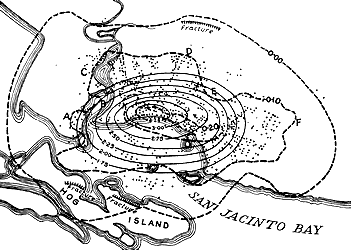Goose Creek

Goose Creek Field, near Baytown, Texas, 20 miles South East of Houston was discovered in 1903 by drilling near gas bubbles in San Jacinto Bay, part of the Galveston Bay complex. Very marginal, sparse drilling occurred until 1908 when more oil was found and in 1916 a 10,000 BOPD well was brought in at 2,100 feet. In 1917 a well called "Sweet 16" was drilled and blew out at the rate of over 35,000 BOPD.
Goose Creek Field is associated with a deep seated salt dome with Miocene age sands from 800 feet down to 3,500 feet draped over the salt extrusion at deposition and Margulina (Frio) age sands down to 4,600 feet that pinched out against the salt wall.

Goose Creek, circ. 1923; Top Salt

Some 1,500 wells, and an unknown number of undocumented dry holes, probably plugged with nothing more than cedar posts, were drilled in Goose Creek. By 1919 the field reached its peak annual production rate of 8,900,000 BO and ultimately has gone on to produce over 150,000,000 barrels of oil. Humble Oil and Refining, Gulf Oil and the Texas Company were the largest producers in the field until the early 1950's.

This discovery coincided perfectly with the onslaught of WW 1 and production from the field played a big role in fueling the allied war effort in Europe. Most of the oil from discovery to 1920 was sold for $1.35 per barrel. Goose Creek was the first effort in Texas, and the second effort in the United States at "offshore" platforms to facilitate drilling wells. Goose Creek still produces oil today.
Goose Creek is rather famous, or infamous, as the case may be, for being one of the first cases of significant surface subsidence in the United States (see Signal Hill/Long Beach Fields in the Los Angles Basin of Southern California), due directly to large withdrawal volumes of hydrocarbons and produced water. Most of the subsidence in Goose Creek is limited to the productive limits of the field and was first documented in 1926 by the famous geologist, Walter Pratt. Some of that subsidence is as much as 4-5 feet in parts of Baytown and some wellheads in Goose Creek that use to be above water, or on dry land, are now below water , extended, and produced by rod lift off small platforms.
In the photograph below (circ. 1926) there is an obvious fault trace on the surface with what appears to be about 12-18 inches of displacement, or subsidence, basin ward, toward the marsh. There are some good papers about subsidence in Goose Creek written by the Houston Geological Society:

Another bit of novelty about the history of this field is that Howard Hughes, Sr., in 1909, was reported to have tested the very first cone-journal drilling bit in Goose Creek.

Goose Creek Field, 1921